Applied Research Project: Observing Social Behavior in Public Spaces
VerifiedAdded on 2023/01/10
|7
|1095
|97
Project
AI Summary
This project is a research proposal focusing on applied research through non-participant observation, specifically examining the social dynamics and cultural perceptions surrounding Canadian Sikhs in public spaces. The study aims to understand the impact of societal attitudes and potential cultural gaps by observing behaviors in public settings like Bayfront Park. The research employs the Functionalism Theory to analyze societal functions and relationships. The methodology includes observing family interactions and analyzing their behavior towards Sikhs, while also considering front-stage and back-stage behaviors. The proposal outlines the observation process, data collection methods, and timeline for the project. The student plans to disguise themselves as a Sikh to observe reactions, and the collected data will be analyzed to draw conclusions about societal attitudes and potential biases. The research also cites the provided article "Field Research as Social Experience: Learning to Do Ethnography" as a source for the project.
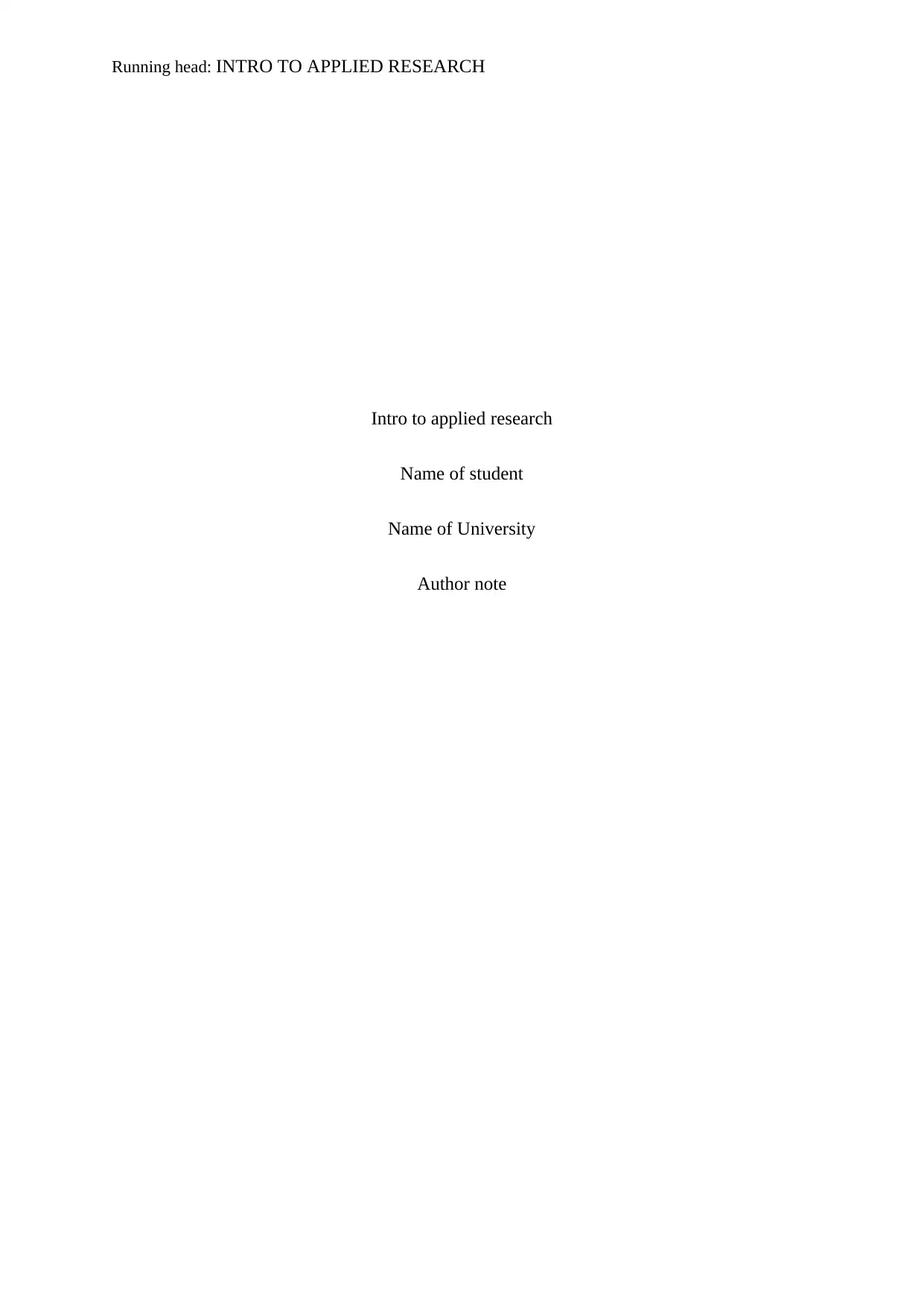
Running head: INTRO TO APPLIED RESEARCH
Intro to applied research
Name of student
Name of University
Author note
Intro to applied research
Name of student
Name of University
Author note
Paraphrase This Document
Need a fresh take? Get an instant paraphrase of this document with our AI Paraphraser
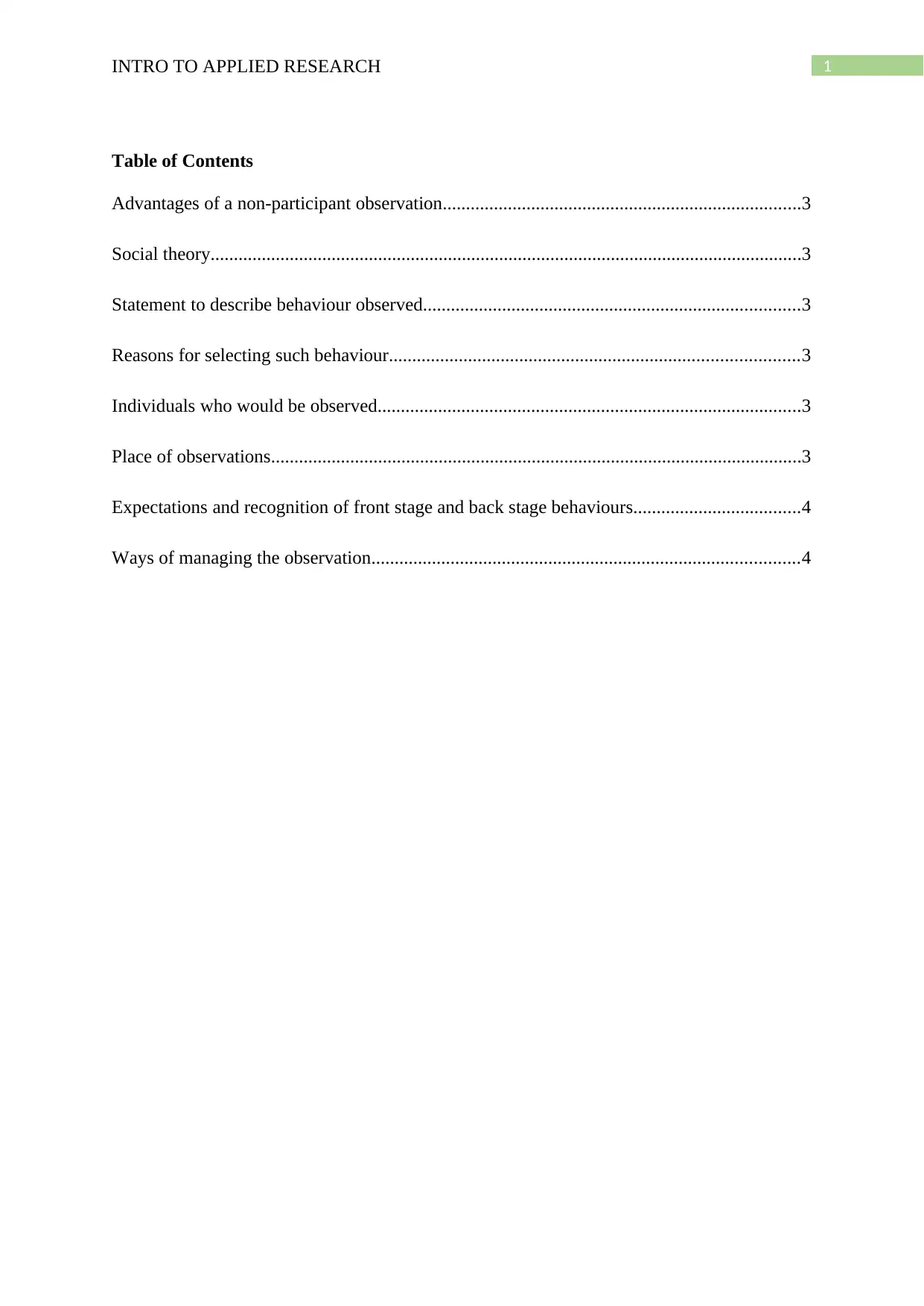
1INTRO TO APPLIED RESEARCH
Table of Contents
Advantages of a non-participant observation.............................................................................3
Social theory...............................................................................................................................3
Statement to describe behaviour observed.................................................................................3
Reasons for selecting such behaviour........................................................................................3
Individuals who would be observed...........................................................................................3
Place of observations..................................................................................................................3
Expectations and recognition of front stage and back stage behaviours....................................4
Ways of managing the observation............................................................................................4
Table of Contents
Advantages of a non-participant observation.............................................................................3
Social theory...............................................................................................................................3
Statement to describe behaviour observed.................................................................................3
Reasons for selecting such behaviour........................................................................................3
Individuals who would be observed...........................................................................................3
Place of observations..................................................................................................................3
Expectations and recognition of front stage and back stage behaviours....................................4
Ways of managing the observation............................................................................................4
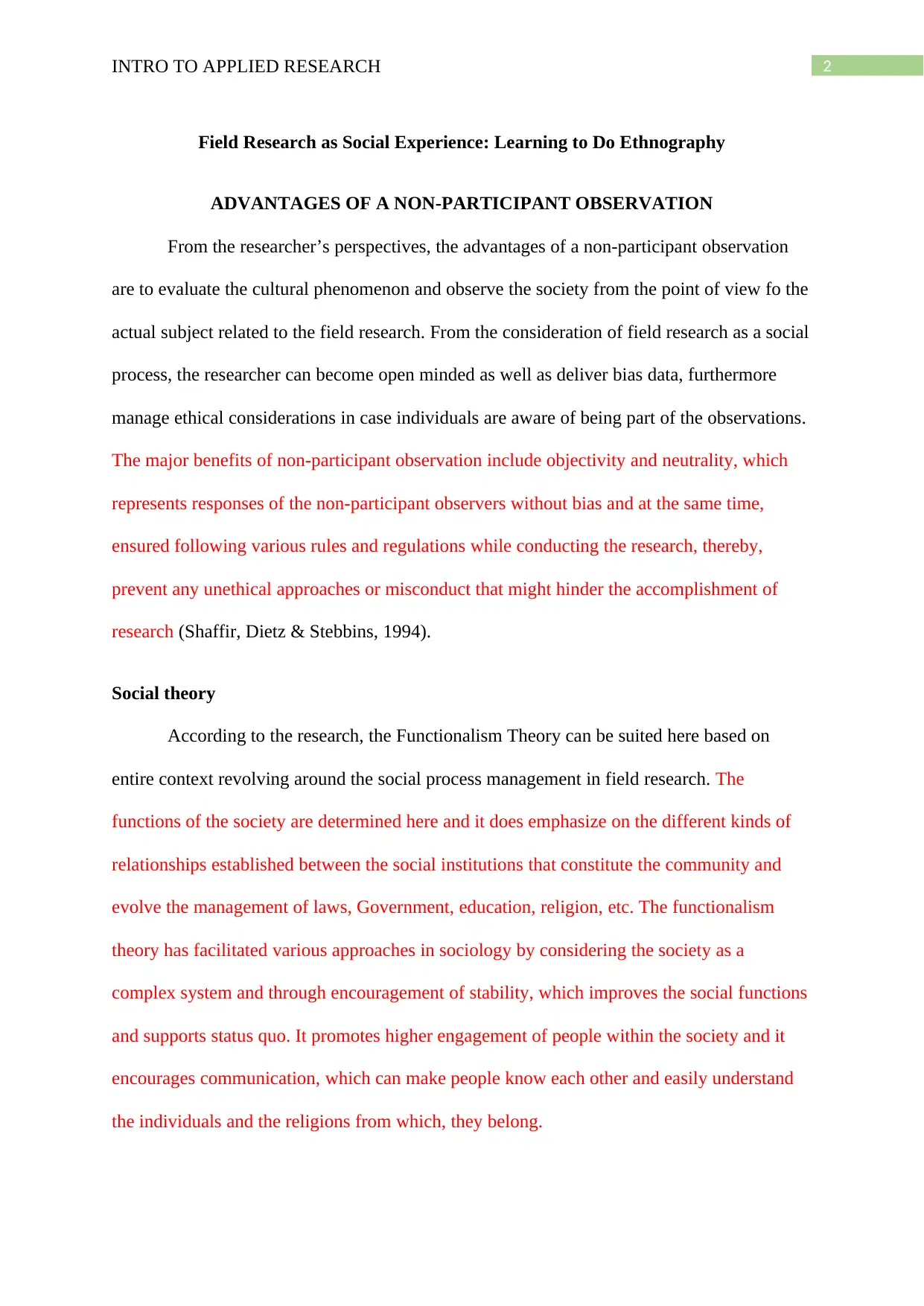
2INTRO TO APPLIED RESEARCH
Field Research as Social Experience: Learning to Do Ethnography
ADVANTAGES OF A NON-PARTICIPANT OBSERVATION
From the researcher’s perspectives, the advantages of a non-participant observation
are to evaluate the cultural phenomenon and observe the society from the point of view fo the
actual subject related to the field research. From the consideration of field research as a social
process, the researcher can become open minded as well as deliver bias data, furthermore
manage ethical considerations in case individuals are aware of being part of the observations.
The major benefits of non-participant observation include objectivity and neutrality, which
represents responses of the non-participant observers without bias and at the same time,
ensured following various rules and regulations while conducting the research, thereby,
prevent any unethical approaches or misconduct that might hinder the accomplishment of
research (Shaffir, Dietz & Stebbins, 1994).
Social theory
According to the research, the Functionalism Theory can be suited here based on
entire context revolving around the social process management in field research. The
functions of the society are determined here and it does emphasize on the different kinds of
relationships established between the social institutions that constitute the community and
evolve the management of laws, Government, education, religion, etc. The functionalism
theory has facilitated various approaches in sociology by considering the society as a
complex system and through encouragement of stability, which improves the social functions
and supports status quo. It promotes higher engagement of people within the society and it
encourages communication, which can make people know each other and easily understand
the individuals and the religions from which, they belong.
Field Research as Social Experience: Learning to Do Ethnography
ADVANTAGES OF A NON-PARTICIPANT OBSERVATION
From the researcher’s perspectives, the advantages of a non-participant observation
are to evaluate the cultural phenomenon and observe the society from the point of view fo the
actual subject related to the field research. From the consideration of field research as a social
process, the researcher can become open minded as well as deliver bias data, furthermore
manage ethical considerations in case individuals are aware of being part of the observations.
The major benefits of non-participant observation include objectivity and neutrality, which
represents responses of the non-participant observers without bias and at the same time,
ensured following various rules and regulations while conducting the research, thereby,
prevent any unethical approaches or misconduct that might hinder the accomplishment of
research (Shaffir, Dietz & Stebbins, 1994).
Social theory
According to the research, the Functionalism Theory can be suited here based on
entire context revolving around the social process management in field research. The
functions of the society are determined here and it does emphasize on the different kinds of
relationships established between the social institutions that constitute the community and
evolve the management of laws, Government, education, religion, etc. The functionalism
theory has facilitated various approaches in sociology by considering the society as a
complex system and through encouragement of stability, which improves the social functions
and supports status quo. It promotes higher engagement of people within the society and it
encourages communication, which can make people know each other and easily understand
the individuals and the religions from which, they belong.
⊘ This is a preview!⊘
Do you want full access?
Subscribe today to unlock all pages.

Trusted by 1+ million students worldwide
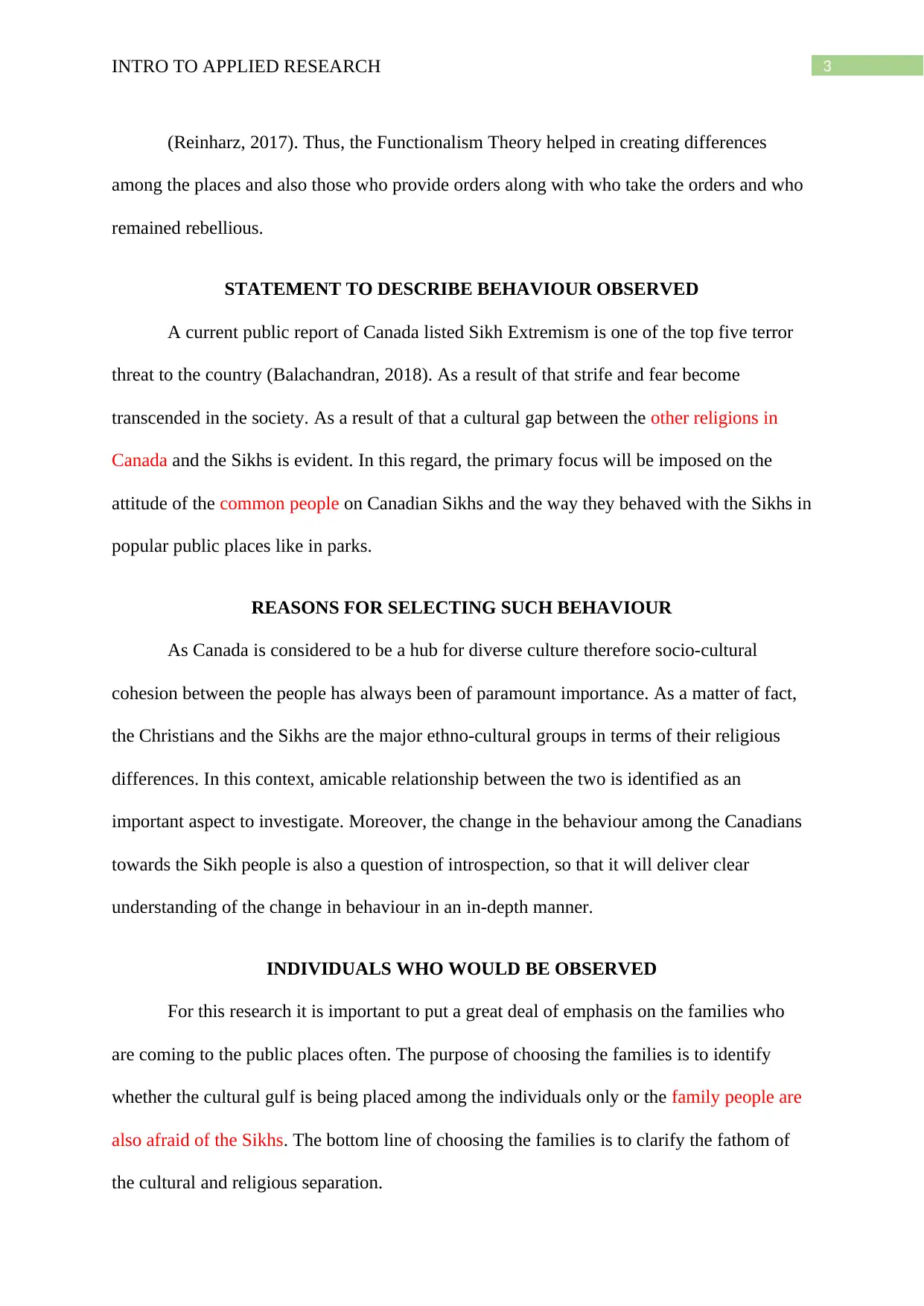
3INTRO TO APPLIED RESEARCH
(Reinharz, 2017). Thus, the Functionalism Theory helped in creating differences
among the places and also those who provide orders along with who take the orders and who
remained rebellious.
STATEMENT TO DESCRIBE BEHAVIOUR OBSERVED
A current public report of Canada listed Sikh Extremism is one of the top five terror
threat to the country (Balachandran, 2018). As a result of that strife and fear become
transcended in the society. As a result of that a cultural gap between the other religions in
Canada and the Sikhs is evident. In this regard, the primary focus will be imposed on the
attitude of the common people on Canadian Sikhs and the way they behaved with the Sikhs in
popular public places like in parks.
REASONS FOR SELECTING SUCH BEHAVIOUR
As Canada is considered to be a hub for diverse culture therefore socio-cultural
cohesion between the people has always been of paramount importance. As a matter of fact,
the Christians and the Sikhs are the major ethno-cultural groups in terms of their religious
differences. In this context, amicable relationship between the two is identified as an
important aspect to investigate. Moreover, the change in the behaviour among the Canadians
towards the Sikh people is also a question of introspection, so that it will deliver clear
understanding of the change in behaviour in an in-depth manner.
INDIVIDUALS WHO WOULD BE OBSERVED
For this research it is important to put a great deal of emphasis on the families who
are coming to the public places often. The purpose of choosing the families is to identify
whether the cultural gulf is being placed among the individuals only or the family people are
also afraid of the Sikhs. The bottom line of choosing the families is to clarify the fathom of
the cultural and religious separation.
(Reinharz, 2017). Thus, the Functionalism Theory helped in creating differences
among the places and also those who provide orders along with who take the orders and who
remained rebellious.
STATEMENT TO DESCRIBE BEHAVIOUR OBSERVED
A current public report of Canada listed Sikh Extremism is one of the top five terror
threat to the country (Balachandran, 2018). As a result of that strife and fear become
transcended in the society. As a result of that a cultural gap between the other religions in
Canada and the Sikhs is evident. In this regard, the primary focus will be imposed on the
attitude of the common people on Canadian Sikhs and the way they behaved with the Sikhs in
popular public places like in parks.
REASONS FOR SELECTING SUCH BEHAVIOUR
As Canada is considered to be a hub for diverse culture therefore socio-cultural
cohesion between the people has always been of paramount importance. As a matter of fact,
the Christians and the Sikhs are the major ethno-cultural groups in terms of their religious
differences. In this context, amicable relationship between the two is identified as an
important aspect to investigate. Moreover, the change in the behaviour among the Canadians
towards the Sikh people is also a question of introspection, so that it will deliver clear
understanding of the change in behaviour in an in-depth manner.
INDIVIDUALS WHO WOULD BE OBSERVED
For this research it is important to put a great deal of emphasis on the families who
are coming to the public places often. The purpose of choosing the families is to identify
whether the cultural gulf is being placed among the individuals only or the family people are
also afraid of the Sikhs. The bottom line of choosing the families is to clarify the fathom of
the cultural and religious separation.
Paraphrase This Document
Need a fresh take? Get an instant paraphrase of this document with our AI Paraphraser
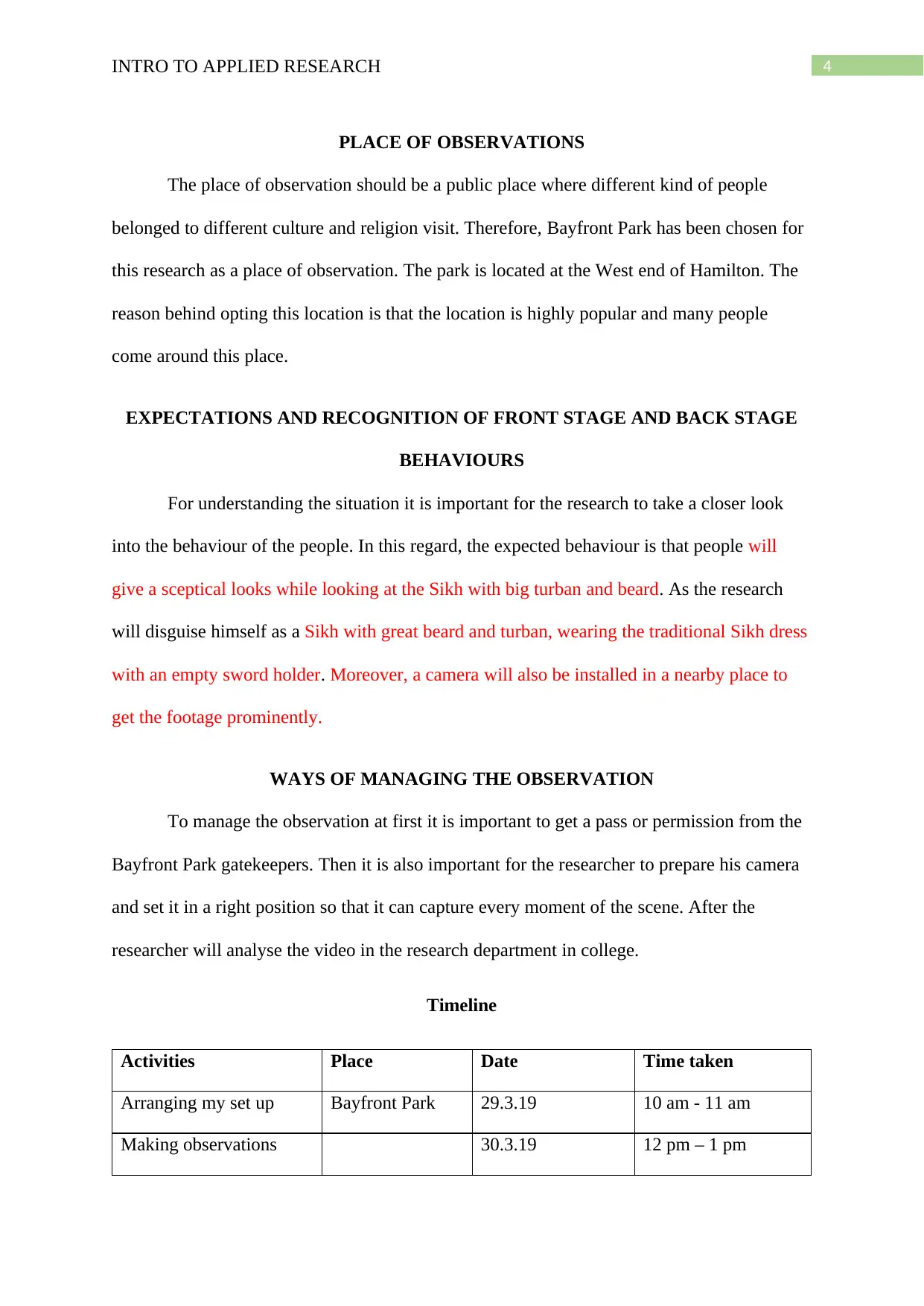
4INTRO TO APPLIED RESEARCH
PLACE OF OBSERVATIONS
The place of observation should be a public place where different kind of people
belonged to different culture and religion visit. Therefore, Bayfront Park has been chosen for
this research as a place of observation. The park is located at the West end of Hamilton. The
reason behind opting this location is that the location is highly popular and many people
come around this place.
EXPECTATIONS AND RECOGNITION OF FRONT STAGE AND BACK STAGE
BEHAVIOURS
For understanding the situation it is important for the research to take a closer look
into the behaviour of the people. In this regard, the expected behaviour is that people will
give a sceptical looks while looking at the Sikh with big turban and beard. As the research
will disguise himself as a Sikh with great beard and turban, wearing the traditional Sikh dress
with an empty sword holder. Moreover, a camera will also be installed in a nearby place to
get the footage prominently.
WAYS OF MANAGING THE OBSERVATION
To manage the observation at first it is important to get a pass or permission from the
Bayfront Park gatekeepers. Then it is also important for the researcher to prepare his camera
and set it in a right position so that it can capture every moment of the scene. After the
researcher will analyse the video in the research department in college.
Timeline
Activities Place Date Time taken
Arranging my set up Bayfront Park 29.3.19 10 am - 11 am
Making observations 30.3.19 12 pm – 1 pm
PLACE OF OBSERVATIONS
The place of observation should be a public place where different kind of people
belonged to different culture and religion visit. Therefore, Bayfront Park has been chosen for
this research as a place of observation. The park is located at the West end of Hamilton. The
reason behind opting this location is that the location is highly popular and many people
come around this place.
EXPECTATIONS AND RECOGNITION OF FRONT STAGE AND BACK STAGE
BEHAVIOURS
For understanding the situation it is important for the research to take a closer look
into the behaviour of the people. In this regard, the expected behaviour is that people will
give a sceptical looks while looking at the Sikh with big turban and beard. As the research
will disguise himself as a Sikh with great beard and turban, wearing the traditional Sikh dress
with an empty sword holder. Moreover, a camera will also be installed in a nearby place to
get the footage prominently.
WAYS OF MANAGING THE OBSERVATION
To manage the observation at first it is important to get a pass or permission from the
Bayfront Park gatekeepers. Then it is also important for the researcher to prepare his camera
and set it in a right position so that it can capture every moment of the scene. After the
researcher will analyse the video in the research department in college.
Timeline
Activities Place Date Time taken
Arranging my set up Bayfront Park 29.3.19 10 am - 11 am
Making observations 30.3.19 12 pm – 1 pm

5INTRO TO APPLIED RESEARCH
Analysing the video
footages
Research
department
31.3.19 2 pm – 3 pm
Analysing the video
footages
Research
department
31.3.19 2 pm – 3 pm
⊘ This is a preview!⊘
Do you want full access?
Subscribe today to unlock all pages.

Trusted by 1+ million students worldwide
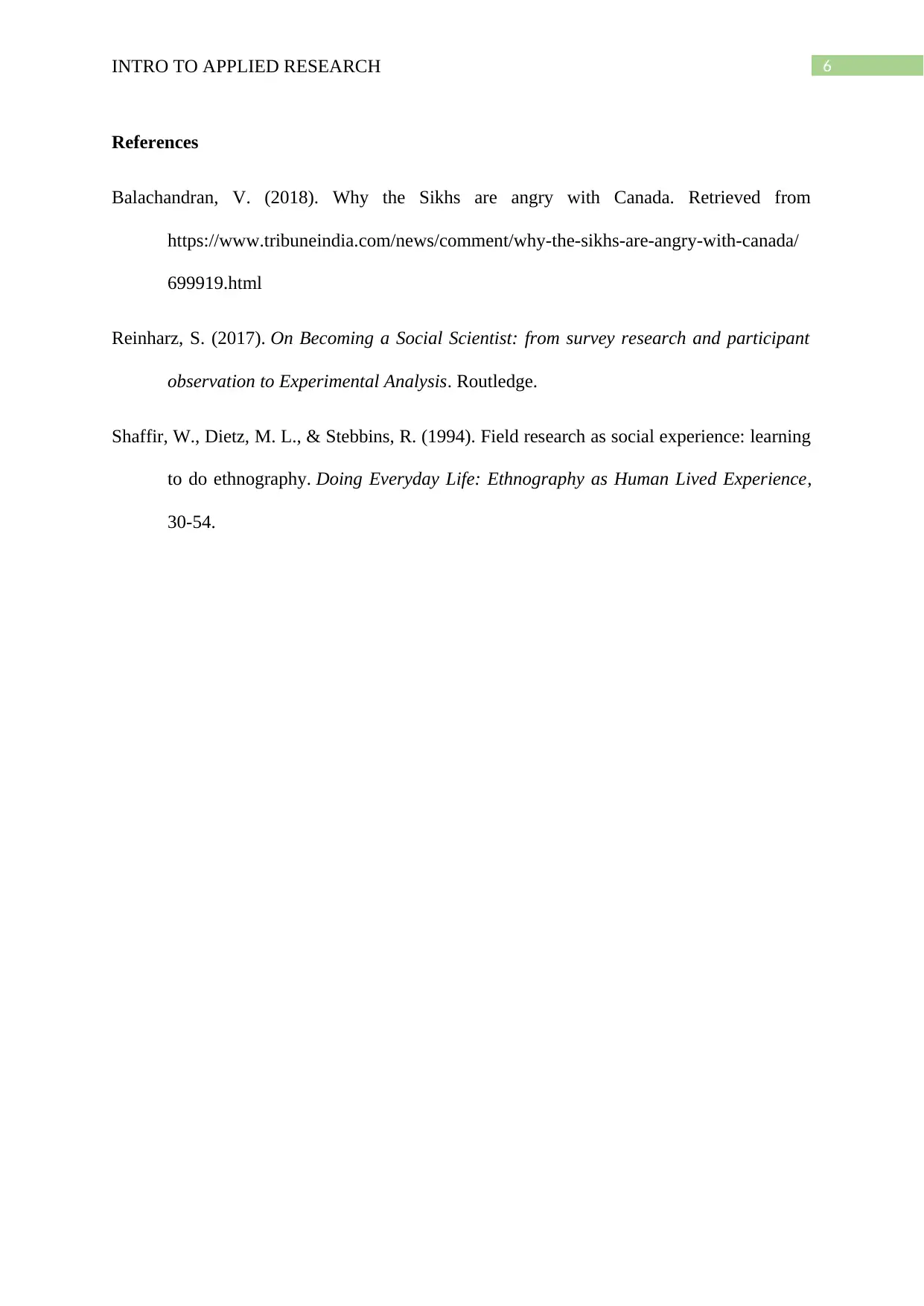
6INTRO TO APPLIED RESEARCH
References
Balachandran, V. (2018). Why the Sikhs are angry with Canada. Retrieved from
https://www.tribuneindia.com/news/comment/why-the-sikhs-are-angry-with-canada/
699919.html
Reinharz, S. (2017). On Becoming a Social Scientist: from survey research and participant
observation to Experimental Analysis. Routledge.
Shaffir, W., Dietz, M. L., & Stebbins, R. (1994). Field research as social experience: learning
to do ethnography. Doing Everyday Life: Ethnography as Human Lived Experience,
30-54.
References
Balachandran, V. (2018). Why the Sikhs are angry with Canada. Retrieved from
https://www.tribuneindia.com/news/comment/why-the-sikhs-are-angry-with-canada/
699919.html
Reinharz, S. (2017). On Becoming a Social Scientist: from survey research and participant
observation to Experimental Analysis. Routledge.
Shaffir, W., Dietz, M. L., & Stebbins, R. (1994). Field research as social experience: learning
to do ethnography. Doing Everyday Life: Ethnography as Human Lived Experience,
30-54.
1 out of 7
Related Documents
Your All-in-One AI-Powered Toolkit for Academic Success.
+13062052269
info@desklib.com
Available 24*7 on WhatsApp / Email
![[object Object]](/_next/static/media/star-bottom.7253800d.svg)
Unlock your academic potential
Copyright © 2020–2025 A2Z Services. All Rights Reserved. Developed and managed by ZUCOL.





